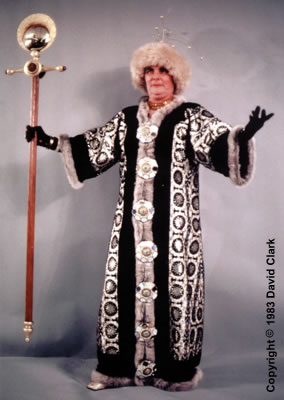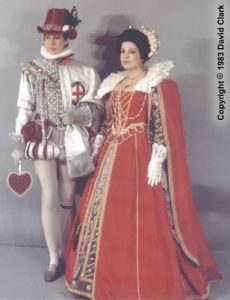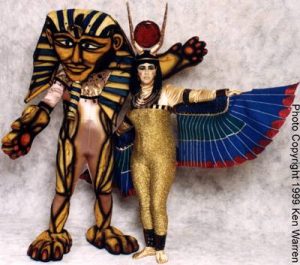Review – The San Diego Union
January 17, 1983
Fit To Be Eyed
Costumes Are Clothes To The Truth
By LUCRETIA STEIGER
Staff Writer, The San Diego Union
Mission Bay glittered in the background as the lady in the green velvet Victorian walking suit settled herself on the filigree iron chair.
Next to her was a friend in a spangled gold mask with long antennae and a pant-suit printed with Darth Vader’s dark image.
A spacewoman in a white satin cape joined them.
Not a convention of strange people, but a group of costume buffs enjoying themselves this weekend at the Bahia Hotel.
About 150 amateur costumers met to exchange ideas at workshops and seminars, and show off costumes at parties and fashion shows. Several were members of the Fantasy Costumers Guild of Spring Valley, and others came from costume guilds across the United States and Canada.
Costumers can go either way: back in history to copy designs exactly from drawings and literary descriptions, or forward into the sleek and functional future. What they can’t do, says Peggy Kennedy of New York, is wear a purchased costume in competition, or even one someone else has made. Their best work, and the costumes they show off at the party or exhibit, should be their own.
“To show something rented is beyond the pale,” Kennedy added, smoothing the green velveteen skirt of her riding suit. She had hand-appliqued the flower tracery on the lapels and added a ruffled petticoat, as Victorians did. Costume buffs go for accuracy, she said, even to the tight corsets which women gave up long ago. The underpinnings have to be right, they point out, for the wearer to maintain the correct carriage of the times and “look right.”
So considerable research is involved in creating these costumes, said Astrid Anderson of Spring Valley. She helped put on the convention and has been interested in costumes since childhood. Her costume-buff mother made her robes and gowns then, many with a futuristic theme since her father writes science fiction stories.
Today Anderson creates her own, and some are spectacular, such as the recent mermaid outfit she wore to one of the guild’s competitions complete with tail in which she had to be carried about by a man dressed as Poseidon, god of the sea.
“Astrid’s much into fairy tales and mythological dressing,” one of the group explained.
They all choose to wear costumes “because it’s fun and a method of creative expression,” they said almost in unison, and it allows each to become someone else, at least temporarily.
Kennedy is a research scientist; Anderson a bookkeeper, the antennaed lady a homemaker; and the caped spacewoman a technical editor for an electronics company.
It’s non-verbal acting,” said novelist Adrienne Martine-Barnes, dressed in a black taffeta, net and beaded gown which could have been worn in the 1850s, complete with feather fan and “dance loop.” (That’s a foot-loon loop of fabric attached to the back of the skirt for dancing.) “It gives you insight into the times when they wore these clothes. You become the character, the way you’re dressed.
About two-thirds of the members are sci-fi buffs and interested in futuristic dressing, “the way you might dress in everyday clothing in an alternative universe,” Kennedy explained. The rest go for historical costumes. The costume buffs range in age from 18 to 80, and most get started through reading history or science-fiction books.
What they learn about the costumes seems to add the dimension of living part of history – or the future – to their lives. They know lots of fascinating details: that pantaloons worn beneath hoop skirts had no center seam; or that Elizabethan court dress for women was cut so tightly that the wearer could not bend over, thus providing work for half a dozen minions who were summoned to pick up whatever she dropped or to help her in or out of her clothing.
The tight sleeves of Victorian dresses prohibited the women from raising their arms above shoulder height. That’s one of the reasons they are usually shown with hands clasped demurely in front, Martine-Barnes said.
Clothing often has symbolized the political climate of its time, Kennedy added. Today’s “punk dressing, which started with an adolescent group in England, is a form of social protest. And what you wear often is a statement of what your place is in society.”
How you put it together with makeup and accessories and then how you present it through wearing are equally as important as the clothing, she said, even when you’re dealing with such new worlds as the Intergalactic Empire.
“We went to see ‘Star Wars,’ and when Princess Leia came in, I said to my husband, ‘That’s no princess.’ She didn’t walk right; she didn’t have the bearing of a princess. Princesses don’t schlep around. They walk with presence and dignity. I knew right away that was wrong.”
The rest of the group agreed, then each arose and left the hotel patio in fitting manner. The spacewoman swooped, the beaded black evening dress sailed, the mask prowled. They were off, Anderson explained, not forward in time but backward, to a little Regency dancing.
“That’s a cross between the Virginia reel and square dancing,” she explained, “and it’s loads of fun.”
[Three photographs appeared with this article; Sally C. Fink as ‘Crystal Singer,’ Karen Kuykendall as ‘Empress of the Outer Regions’ and Marty Gear as ‘Jack of Shadows.’ Photos not reproduced due to quality of article’s reproduction. Images of these costumes are available elsewhere on this web site.]


